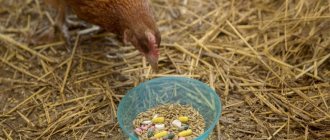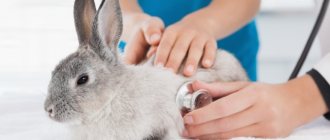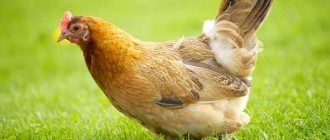Causes of diarrhea
What to do if chickens and adult poultry are stricken? How to treat them? Such questions interest all beginning farmers without exception. Diarrhea in birds, which is characterized by frequent watery stools, can occur against the background of a variety of unfavorable factors. Moreover, before taking appropriate measures, it is necessary to establish the root cause, to find out why the bird began to diarrhea heavily.
If a chicken has severe profuse diarrhea, black, green, white loose stools, blood, a large amount of mucus, foam is noticeable in the droppings, a veterinarian should prescribe adequate medical therapy, taking into account the cause of this condition.
Causes of diarrhea in laying hens:
- unbalanced diet;
- feeding with low-quality, low-grade feed;
- poisoning with chemicals, pesticides, poisons;
- frequent severe stressful situations;
- poor living conditions, lack of hygiene in poultry houses;
- metabolic disorder;
- sudden change in diet;
- hypothermia;
- colds;
- infectious, bacterial infections;
- helminthic infestations.
Diarrhea in chickens and laying hens can be caused by long-term use of pharmacological drugs, medications, in particular antibiotics. An upset stomach in birds is often caused by seeds of poisonous plants (euphorbia, buttercup, dope), which provoke severe poisoning and intoxication.
Unfortunately, not all owners, when setting up chicken coops, pay attention to the quality characteristics of the materials used, which can also cause diarrhea in poultry. So, if the dishes contain a large amount of zinc, copper - such chemical elements can cause severe diarrhea in chickens and adult hens.
Additional care tips
In order for chickens to get sick as little as possible, it is necessary:
- Add and change litter regularly. It must be clean and dry.
- Install high-quality ventilation in the poultry house, which will remove excess moisture and maintain air humidity at the proper level.
- Install heating in the chicken coop for the winter.
- Make sure that there are no drafts in the room where the chickens are kept.
- Let the birds go for a walk every day.
- It is advisable to install nipple-type drinkers in the chicken coop.
- Adhere to the chicken coop population norm of 3-4 chickens per 1 sq. m with floor keeping and up to 10 individuals per 1 sq. m at cellular.
To summarize, we note that diarrhea in chickens can be a symptom of various diseases or indicate a problem in feeding or maintenance. To eliminate it, you need to correctly determine the cause. Most often, diarrhea is caused by factors that are easily eliminated, and treatment takes place quickly - within 2-3 days. However, in cases of some infectious diseases, therapy may not be appropriate.
Symptoms of diarrhea in birds
In addition to frequent bowel movements and liquid droppings, which may contain bloody clots, threads, inclusions, and remnants of undigested food, birds with diarrhea experience various side symptoms:
- feathers in the cloaca area soiled with feces;
- decreased, lack of appetite;
- the presence of a large amount of liquid droppings in poultry houses;
- lethargy, drowsiness, depression;
- adult birds and young birds quickly lose weight;
- increased thirst;
- problems in the gastrointestinal tract;
- there is mucus in the droppings.
When laying hens have severe diarrhea, sticky black droppings mixed with blood can be seen on the surface of the eggshell. In a sick bird, coordination of movements is impaired, it becomes timid, inactive, the condition of the feather cover worsens, and egg production decreases.
The stool may be white, yellow, dark brown, green, black, or whitish. At the same time, if other symptoms are noticeable - the chicken drinks a lot, looks lethargic, depressed, refuses food and has diarrhea due to infections - it is necessary to isolate the bird, since an infected individual can infect healthy ones.
Important! In small chickens, severe diarrhea can lead to exhaustion, intoxication, cause blockage of the cloaca, and death.
As a rule, viral-bacterial diseases spread through contact and aerogenous means. Although diarrhea in chickens is quite common, in order to prevent the spread of infection, we recommend monitoring the sick chicken. An attentive poultry farmer will give the bird medicine and take appropriate measures.
Green diarrhea
Green diarrhea in laying hens and chickens most often occurs due to the presence of a large amount of plant foods in the diet. Green diarrhea can also occur as a result of severe fright, consumption of low-quality feed, or poisoning by seeds of poisonous plants. If a chicken's stool turns light green, this may indicate that the chicken has a cold.
Green droppings from chickens
Important! Green droppings, viscous foamy diarrhea with a lot of mucus, and bloody spots are most often noted with pasteurellosis. With this infection, chickens die en masse.
If, in addition to green diarrhea, the chicken drinks a lot of water, is lethargic, and refuses to feed, the bird may be infected. In this case, it needs to be separated from other healthy individuals and consulted with a veterinarian regarding therapeutic therapy.
White diarrhea
White diarrhea most often indicates a lack of any vitamins or minerals in the bird’s body. If the feces resemble chalk and have a solid consistency, the chicken must be urgently isolated, since such diarrhea is one of the symptoms of viral, bacterial diseases that are caused by paratyphoid bacteria.
Important! Chicken paratyphoid fever is an acute, highly contagious disease that is very quickly transmitted aerogenically. Most often, the disease is diagnosed in chickens aged 10–14 days.
White diarrhea is observed with salmonellosis, intestinal parasites, and disorders of the digestive tract.
Yellow, brown, brown diarrhea
Yellow, mustard-colored diarrhea, as a rule, develops in laying hens and chickens against the background of viral and bacterial infections. Yellow-white droppings are a symptom of Gumboro disease. If the chicken does not eat or constantly drinks water, it may have a respiratory illness.
Short-term yellow diarrhea in birds can occur with a sudden change in diet, diet, due to stress, or feeding with low-quality grain mixtures.
Brown, black diarrhea indicates functional disorders in the digestive tract. Bloody diarrhea is a sign of an infectious disease.
Bloody diarrhea is most often observed in chickens under 1–2 months of age. Pathogenic flora actively multiplies in the intestines of young individuals, causing disturbances in the functioning of the digestive system. In addition, diarrhea with blood indicates a possible infection of the bird with coccidosis and injury to the cloaca.
Diseases
The list of diseases that domestic chickens can suffer from is quite long. Some can be easily cured, while others have severe pathology and can be dangerous to humans. This material will tell you about diseases of laying hens at home.
Mycoplasmosis
One of the most common diseases affecting the respiratory system of domestic chickens is mycoplasmosis. This disease is widespread throughout the country and can be transmitted to offspring through eggs, as well as by airborne droplets and through food and water. The first symptoms may appear on days 20-45. The mortality rate from mycoplasmosis is 20-30%. To treat sick chickens, the following drugs should be added to the water:
- farmazin;
- entrophlon;
- pneumotil.
The dose depends on the number of chickens on the farm and is indicated on the packaging. The course of treatment does not exceed 5 days.
To prevent respiratory infections, it is necessary to keep birds in good conditions, in compliance with all hygienic requirements.
Newcastle disease
This is a very dangerous viral disease that can destroy both chickens and adults in the shortest possible time. The disease affects all internal organs of the bird . The infection is transmitted through the air. The virus is variable and has many strains, some of which are almost harmless and some of which are deadly to birds.
Treatment of Newcastle disease is impractical, since sick birds remain a source of infection. Such individuals should be destroyed, and healthy birds should be vaccinated.
Colibacillosis
The disease develops rapidly and can destroy up to 30% of chickens in the first day. The source of infection is E. coli, which is found in bird feces. One of the reasons for the occurrence of this disease in small households may be non-compliance with sanitary and hygienic standards, various stresses that reduce the immunity of chickens and contact with infected individuals.
The disease is characterized by the following symptoms:
- temperature increase;
- general lethargy of birds;
- poor appetite;
- diarrhea;
- constant thirst.
To treat colibacillosis, sulfonamide drugs or tetracycline antibiotics are used . For prevention, furatsilin and chloramphenicol can be added to drinking water.
Salmonellosis
This is one of the most dangerous diseases in poultry. Through the eggs and meat of sick birds, carriers of the disease are transmitted to humans, which leads to severe poisoning, which is difficult and time-consuming to treat. The infection can be transmitted through rodents, mealworms and food. Chicks may experience the following symptoms:
- general weakness;
- wheezing when breathing;
- teary eyes.
Treatment and prevention of chicken livestock is carried out with antibiotics, and “Bifinorm” and “Bifidumbacterin” are used to restore the intestinal microflora.
Pasteurellosis
Pasteurellosis or avian cholera can occur in any region. Small private poultry farms are susceptible to this disease. Infection can occur through food, from sick birds and chicken parasites from the genus of mites. In the acute form, the following symptoms appear:
- the hoarse breathing of birds;
- bluishness of the scallop;
- green diarrhea;
- strong thirst.
Livestock mortality can reach 90%, and surviving birds are a lifelong source of infection. The disease cannot be treated, so sick birds are destroyed.
Coccidosis
This disease is caused by single-celled parasites that can enter the bird's body during open range or with low-quality feed. In some cases it is asymptomatic. Young animals with weakened immune systems are most often affected. The disease is characterized by general weakness and liquid feces. To prevent coccidosis, Salinomycin, Narazin and other drugs that destroy single-celled parasites are used. Read about coccidosis in chickens in this article.
Helminthiasis
Helminths or worms in chickens reduce body weight, egg production, and in some cases can cause the death of the bird. Most often, infection occurs when chickens are kept outside. There are many varieties of intestinal parasites. For treatment, antihelminthic drugs “Febendazole” or “Ivermectin” are used, which are active against any parasites. Pumpkin seeds are used as folk remedies, which are added to food, green onions or crushed garlic.
The structure of worms.
Feeding problems
Feed factors that cause diarrhea in chickens are usually easy to recognize. They are distinguished by massive manifestations of signs of the disease, which develop immediately after the introduction of new food. What measures should be taken in this case?
Bad food
Poisoning is accompanied by goiter atony, loss of appetite; feces are greenish or brown in color, sometimes foamy, with undigested particles. The food is replaced; if this is not possible, then it is diluted with good food in as large a proportion as possible.
A good effect is obtained from introducing adsorbents into the diet - substances that absorb toxic components - zeolites, clay water, "Mikosorb" in a dosage of 10 grams of the drug per 10 kg. compound feed.
In case of acute poisoning, drink 0.02% solution of potassium permanganate, 0.05% solution of formalin, 0.2% solution of copper sulfate. They give antibacterial agents.
Overfeeding with grass
Increased gas formation, watery droppings. Goes away without treatment.
Unbalanced diet
Excess protein is accompanied by increased secretion of uric acid - a white coating on the droppings. Excess carbohydrates in the diet causes fermentation in the intestines, stool mixed with gas, and an unpleasant odor. Excessive amounts of fat (such as vegetable oil) cause light or dark sticky droppings.
Insufficient attention to water quality
When drinking bowls and their grooves are contaminated, as well as when drinking poor-quality water, the chicken may develop diarrhea as a result of a microbial infection. If a bird drinks bad water, it gets poisoned.
Litter assessment
In order to promptly respond to the presence of diarrhea and take action, it is necessary to monitor the condition of the litter and the quality of the droppings. There are 2 types of normal feces - intestinal and cecal. They differ in color and consistency.
Intestinal droppings occur throughout the day. Its shape resembles oblong brown or dark brown granules, which are easy to find on the litter and inspect. As a rule, the inherent white deposits are located on top and are uric acid salts, which are absorbed from chickens along with urine secretions in the cloaca, and then excreted in feces. If the pellet is irregular in shape, then the chicks need to be provided with more warmth or the right food. If maintenance and feeding standards are strictly adhered to, then the onset of the disease should be considered the cause.
Excretion of fecal droppings occurs once during the day. This is the result of 24-hour etching of food in the caeca. A dark brown liquid that becomes lighter in color when many nutrients remain in the small intestine. This picture is complemented by a more liquid consistency and an admixture of gases.
Gas bubbles, mucus and blood are not normal parts of any litter. Indigestion is indicated by yellow, green, orange or white color of the droppings, dampness and slipperiness of the litter. Laying hens are controlled by their eggs: cleanliness of the shell means the health of the chicken.
Infections
Briefly about the nature of diarrhea in the main viral and bacterial diseases of chickens.
- Gumboro Disease The droppings are yellowish-white in color. A characteristic sign at autopsy is changes in the bursa of Fabricius.
- Newcastle disease The discharge is liquid, brown, mixed with mucus. Characteristically, there are signs of damage to the respiratory system.
- Colibacillosis Mainly affects chickens up to 60 days of age, accompanied by exhaustion and signs of damage to other organs (eyes, respiratory system, umbilical ring in day-old chicks).
- Salmonellosis The droppings are mucous, sometimes the diarrhea is completely white, resembling snot. Often accompanied by lameness.
- Pasteurellosis Green droppings mixed with blood, viscous mucus is released from the cloaca. Accompanied by symptoms of lung damage.
- Clostridiosis Dark droppings with gas bubbles and a foul odor.
Diarrhea, which occurs with all these diseases, requires immediate treatment with antibiotics, nitrofurans, and sulfonamides.
Parasites
Parasitic causes of diarrhea in chickens in most cases are as follows:
Coccidiosis
Discharge of viscous droppings mixed with mucus and blood, sometimes orange streaks are visible. When there is a massive infestation of certain types of coccidia, chickens literally begin to experience bloody diarrhea. Treatment is a course of coccidiostatics (amprolium, salinomycin, Baycox).
Intestinal helminths
They cause a variety of digestive disorders, including diarrhea of various types. They are diagnosed by detecting worms and their eggs in the intestines of killed birds or in the droppings. Treatment is anti-helminth drugs, for example albendazole (Alben), nilverm (Dekaris), fenasal (Bayer 2353).
Yellow diarrhea in chickens is also often the first sign of roundworm (nematode) infection.
What to do? How to treat?
The choice of method and method of treating diarrhea in chickens depends on the reasons that caused this symptom. That is why, if diarrhea is detected, it is necessary to show the bird to a veterinarian and conduct all the necessary laboratory tests.
After this, the specialist will help you choose the most effective treatment, drug and its dosage.
Conservative treatment
First of all, all factors that could lead to diarrhea in chickens should be eliminated. In addition, non-drug therapy is used for diarrhea that was caused by poisoning, exposure to external factors, and not infection.
Features of treatment:
- isolate the sick bird from the flock, adjust the diet. It is especially important to exclude protein foods, as well as greens and sweet solutions (sugar and glucose). The chicken is transferred to a balanced feed depending on its age;
- if diarrhea was caused by hypothermia or stress, high-quality heating should be provided, as well as creating comfortable living conditions for the chicken;
- in case of poisoning or attacks of non-infectious gastritis, you need to balance the diet, and also add activated carbon or a little wood ash to the food. It is important to provide the bird with constant access to clean drinking water;
- for viral infections in adults and young animals, in addition to medications, dairy products, for example, yogurt or whey, are introduced into the diet;
- short-term yellow diarrhea can be cured by feeding the birds an aqueous clay solution, rice or oatmeal broth to strengthen the droppings. Also, a decoction of chamomile or St. John's wort as a food demonstrates great effectiveness;
- for mild diarrhea, chickens are given 1% potassium permanganate with the addition of a saline solution (sodium chloride) to restore the electrolyte balance of the body.
Such treatment measures are used only for non-infectious diarrhea; if the diarrhea was caused by bacteria or viruses, veterinary medications cannot be avoided.
Drug therapy
In most cases, diarrhea is caused by a bacterial infection.
To treat it, the following treatment regimen is used:
- Taking antibiotics . The course lasts from 3 to 5 days. The following drugs are used for treatment: Ciprofloxacin, Biomycin, Furazolidone and Levomycetin. The choice of a specific antibiotic and its dosage should only be made by a veterinarian, taking into account the age, weight and general health of the bird;
- Probiotics . Necessary for restoring the natural intestinal microflora, and are also used as maintenance therapy during antibiotic treatment. The most effective probiotics for poultry: Bifidumbacterin, Acylact, Colibacterin, Lactobacterin. The products are added to the feed 2 times a day, the dosage depends on the weight and age of the chicken. Pharmacy probiotics can be replaced by regularly adding curdled milk or whey to daily feeding;
- Vitamins . They are used to restore the entire body, improve the functioning of the gastrointestinal tract and liver. Water-soluble vitamins are used for up to 7 days, vitamin premixes can be used for up to 14 days. You can treat with drugs: Vitaminol, Aminovital, Chiktonik.
During the entire period of treatment for diarrhea, it is important to regularly conduct veterinary examinations, monitor the general health of the birds, as well as the color and consistency of the droppings.
Other causes of diarrhea
In some cases, diarrhea may develop for other reasons:
- Pullorosis. White bacillary diarrhea is an infectious disease caused by Escherichia coli. Salmonella pullorom and Salmonella galinarum are dangerous bacteria that, if introduced into a chicken coop, can cause white bacilli diarrhea in the entire poultry population.
- Bacteria are transmitted along a chain from one chicken to another, remaining on all objects in the chicken coop. E. coli are especially dangerous for chickens and young animals. Without treatment, chickens die after 4-7 days.
- Worms. Helminth infestation causes severe damage to the bird's body. Most often, breeds that receive animal food are infected with worms: Leghorn, Bielefelder. If there are worms, the chicken begins to have yellow diarrhea, since the parasites negatively affect the bird's liver. Simultaneously with diarrhea, chickens begin to lose weight, stop laying eggs, and lose their appetite.
- Stress. A stressful situation is a common cause of diarrhea in any living creature. In this case, the stool becomes liquid, but does not change color. Sometimes stressful situations cause green diarrhea. Diarrhea due to stress is most common in shy breeds, such as the Ayam Tsemani. Such diarrhea is the only case when a bird can be cured without any medications. Chickens need to create a calm environment.
- Avitaminosis. Lack of vitamins as a cause of loose stools in chickens is observed in early spring. It is worth introducing vitamin and mineral components into the food, and the birds’ digestion will be normalized.
Coccidiosis
Symptoms of the development of the disease in chickens : drooping wings, dirty, tousled plumage, thirst, decreased appetite, leg cramps, pale earrings and comb, greenish diarrhea turning into brownish-brown discharge with bloody streaks, thinning egg shells, decreased productivity of laying hens, depressed state , drowsiness.
- Coccidiosis
- Drugs for treatment: tylosin 50, coxician 12%, coccidiovit, solicox, decox, avatek 15%, rigecostat, hikocicid-17, baycox. Acidophilus is recommended to support the gastrointestinal tract.
- Prevention requires vaccination.
- The disease is fatal to birds.
- In order to combat the disease, disinfection is carried out.
Prevention of diarrhea in chickens
To prevent the occurrence of pathology in chickens, the most experienced farmers carry out preventive measures, since it is always easier to prevent the onset of a disease than to deal with its consequences.
Among the most effective measures to prevent the occurrence of diarrhea in chickens, they name:
- To prevent upset associated with a change in feed ration, it is necessary to practice gradual introduction of complementary feeding components , increasing the proportion of products such as mash, mixed feed and granulated feed gradually.
- Most often, the appearance of microbial infections is associated with the use of the grooved and cup types. Based on this, diarrhea in chickens associated with drinking poor-quality water can be prevented by using nipple-type drinkers when connected to running water from the tap.
- A significant role in the prevention of stool pathologies is played by the organization of timely change of litter in the chicken coop , since even if optimal conditions are provided, over time a certain amount of dangerous pathogenic life forms accumulates in it.
By the way! It is necessary to ensure compliance with sanitary and hygienic conditions in the place used for free-range poultry, which also prevents the occurrence of pathology in chickens.
Isolation of poultry when sick , as well as related procedures, are also preventive measures to prevent infection of the entire population.
Changes in the consistency and color of feces released by laying hens are due to a number of reasons. The key to success in the event of the appearance of pathological discharge in a bird is the correct assessment of the event that caused the appearance of the disorder and its timely elimination or the implementation of the necessary therapeutic measures in response to the disease in chickens.
Use of medications
If chickens are diarrhea even after changing their diet, let's figure out what is the best way to treat them.
Biseptol , which is available in tablet form, can come to the rescue they are crushed and added to the feed, with 8 parts of feed taken for 1 part of the medicine. For chickens, the dosage is halved. Therapy is carried out for 5–7 days.
Another drug that is safe for sensitive layers is Levomycetin ; 4-5 tablets are dissolved in water and poured into a drinking bowl. The result will not take long to wait - in a couple of days all symptoms will disappear without a trace.
To treat small individuals, probiotics , which help restore healthy intestinal microflora and improve the condition of chickens. Fermented milk products such as yogurt and whey, as well as special preparations purchased at a veterinary pharmacy, can act as such a useful remedy.
In severe and advanced cases, antibiotics are used, but such strong medications can only be prescribed by a veterinarian.
After successful therapy, it is recommended to add vitamins to the diet of laying hens. These can be vitamin complexes dissolved in water or mixed with food. Such rehabilitation is recommended to be carried out for 7–14 days. After the chickens become cheerful and cheerful again, and they have an appetite, it is stopped.
Did you know? Chickens are not as stupid as we mistakenly believe. It turns out that a day-old chick can be compared in terms of development to a three-year-old child - the skills they acquire at this age are almost identical.
Folk remedies
In addition to classical methods of treatment, there are a lot of folk, time-tested remedies. Of course, it is better to use them in situations where the disease is not advanced and its cause is reliably known, that is, in its mild forms. All such methods are based on the use of various infusions and decoctions.
Clay water and oat decoction are considered effective remedies - their astringent components can stop diarrhea. Experienced poultry farmers also note positive results after adding wine, which also has astringent qualities, to the drink.
The permissible amount of dry red wine for an adult is 5–10 drops, and for a chicken - no more than 2 drops. The birds are given an alcoholic drink twice a day. You can try giving the birds a drink of chamomile decoction.
A weak solution of potassium permanganate can also come to the rescue in this situation; the main thing is that the concentration of the substance is not too high; the finished drink should have a slight pinkish tint. This therapy gives results within a couple of days.
Diarrhea is very common in birds, so you need to be prepared for it and not panic when it occurs. It is important to remember that timely identification of the cause of the disease will help save the chicken coop population from death. Therefore, experts recommend carefully monitoring the birds’ diet and taking preventive measures in a timely manner.
How to help chickens with diarrhea
Nutrition adjustments
After it has become known why the diarrhea began, its cause must be eliminated.
First of all, it is necessary to give the chickens a balanced feed. Every day, birds need grain mixtures, feed, corn, finely chopped vegetables, and fresh herbs.
It is best to use purchased feed from a trusted manufacturer. If they are made at home, it is necessary to add vitamins and microminerals sold in veterinary pharmacies.
In winter, chickens are fed three times, in summer - twice. During the day they go out for a walk and eat fresh grass.
You cannot suddenly switch birds from homemade food to store-bought food, and vice versa. The transition should be gradual.
The drinking bowls must be filled with fresh water daily. It is better to use vacuum devices to prevent chickens from getting wet.
Diarrhea severely dehydrates the body, so lack of water can lead to the death of chickens.
Conditions of detention
In unsanitary conditions, pathogenic microorganisms spread quickly. Therefore, it is necessary to clean the chicken coop from excrement and feathers every day. The premises are disinfected every two months. And when rodents appear, deratization is carried out.
It is necessary to install ventilation and avoid drafts. If the chicken is still hypothermic, it is placed in a warm place and its health is monitored. If she has cold symptoms, she should be given antiviral drugs.
If the chicken is poisoned
In case of food poisoning, the first step is to identify and eliminate the cause. First aid is provided by adsorbent substances: activated carbon, wood ash. These substances will help neutralize toxins trapped in the intestines.
An additional cleaning and disinfectant is a weak solution of potassium permanganate. You can also feed the chicken oatmeal broth with a few drops of red wine. Wine will have an astringent effect and stop diarrhea.
Remains of the infection are treated with chloramphenicol (5 tablets per liter of water) and biseptol (an eighth of a tablet per chicken twice a day). As a rule, the chicken's condition returns to normal within a week.
How to prevent diarrhea in chickens?
Prevention of diarrhea in birds is to keep the chicken coop clean and dry. The food must be of high quality and complete, the water must be fresh every day. Attention should be paid to the timely prevention of parasites and bacterial diseases, and to exclude the entry of rodents. It is better to keep freshly purchased chickens in quarantine, separate from the main flock, for two weeks. During this time, hidden infections, if any, will appear.
Diarrhea, for whatever reason it begins, is dangerous for the health of chickens due to dehydration and weakened immunity. Sick birds should be removed, healthy birds should be treated prophylactically for the disease that has been identified. Bacterial infections are treated with antibiotics, poisoning and mild digestive disorders are treated with enterosorbents and disinfecting solutions. For example, potassium permanganate. Viruses, as a rule, cannot be treated in any way. The sick individual is killed to prevent the disease from spreading.











